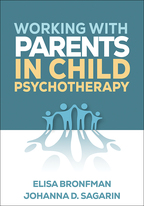Working with Parents in Child Psychotherapy
Elisa Bronfman and Johanna D. Sagarin
The reproducible materials can be downloaded and printed in PDF format.
I. Foundations of Parent Guidance
1. Contributors to Parenting Patterns
2. Strategies for Partnering: Nurturing the Critical Relationships
3. An Assessment to Guide Treatment
II. What You Need to Know to Choose Effective Parent Guidance and Develop Parenting Skills
4. Developing the Path for Intervention
5. Strengthening Optimal Parenting
6. Building Proactive Competence with Parents
III. Choosing and Using Treatment Strategies: Intervening with Common Problems
7. An Introduction to Assessing and Addressing Common Problems (the Usual Suspects)
8. Daily Struggles: Homework, Bedtime, Eating, and Hygiene
9. Other Common Problems That Lead to Frequent Arguments: Digital Media, Going to School, Extracurricular Activities, and Sibling Conflict
IV. Making the Most of Your Behavioral Interventions
10. Commands, Praise, and Feedback
11. Monitoring Behavior as an Intervention
12. Working with Motivational Systems
V. Specific Problems in the Caregiver
13. Helping the Caregiver Who Has Anxiety or Mood Regulation Issues
14. Helping the Caregiver When There Is a Relationship Problem with the Child 
15. Helping the Caregiver Who Makes the Problem Worse
VI. When Something Goes Wrong: Potential Pitfalls in Parent Guidance
16. Pitfalls with the Parent or with the Therapist
17. Pitfalls in the Therapeutic Process
18. Legal and Ethical Concerns: Avoiding Dangers and Reducing Risk
VII. PACT in Action
19. Assessing Progress and Ending Treatment
20. Using PACT to Steer Your Integrative Parent Guidance: A Case Example
Appendix A. Resources for Clinicians
Appendix B. Other Services a Family May Benefit From
References
Index



